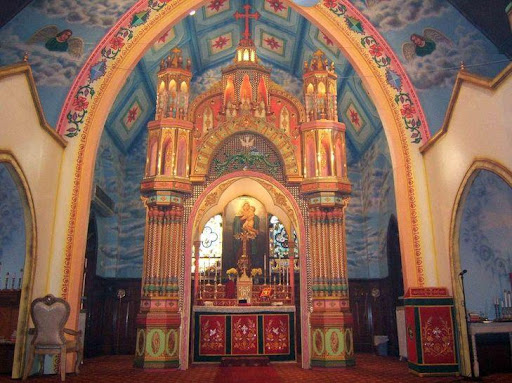The church is divided into four different sections. These sections are as follows.

The Holy Sanctuary (The Madbaha): This section is known more commonly as the most holy place. This division of the church represents heaven and it located at the eastern end of the church as designated by scripture, "Afterward he brought me to the gate, the gate that faces toward the East. And behold the glory of the God of Israel came from the way of the East....and the glory of the Lord came into the temple by way of the gate which faces toward the east" {bible}Ezekiel 43:1-3{/bible}" for the facade of the temple was toward the east..." {bible}Ezekiel 47:1{/bible}. It is in this section of the church that the sacrament of the Body and Blood of our Savior is offered by the holy priest.
The Veil: The veil is a curtain which functions to separate the Madbaha and the Nave. It symbolizes the sky which separates Heaven and Earth. ({bible}Exodus 36:16{/bible}, {bible}Exodus 40:3,21{/bible})
The Altar
The Altar:
The altar is most probably the most significant part of the entire church. It is otherwise known as the 'Table of Life' because it is there that we can find the bread of life. It is often also referred to as the 'Tomb of the Glorified Lord' because it is here that the bread and wine is placed and transformed into the Body and Blood of our Lord and Savior Jesus Christ.The Thabilitho:
This is a piece of wood which symbolizes the cross on which Jesus was crucified. It is deemed mandatory in order for the Holy Qurbana to take place. It is placed at the center of the altar and covered with cloth. The Body and Blood of Christ are placed upon it. The Thabiltho is consecrated with Holy Chrism by a Bishop during the consecration of a church. Each tabalitho has the same message inscribed on it, "The Holy Ghost has hallowed this tabalitho by the hands of Mar..." and the year.
The Cross:
The cross can be found at the center of the altar. It represents the crucifixion of Jesus Christ, the greatest sacrifice and is often thought of as a weapon against Satan. The Cross signifies peace, victory, and salvation.
The sign of cross is executed using three fingers on the right hand, the thumb, first finger, and second finger. These fingers are joined together and the thumb and second finger are bent lower then the first finger to represent Christ as the one and only Savior. This hand is brought from the forehead, down to the chest and then from the left shoulder to the right. This is done to symbolize that the Jesus, came down to earth from heaven, and redeemed our earthly body from the gloomy paths of darkness (left shoulder), to the paths of truth and light (right shoulder).
Candles: Jesus said "I am the light of the world; he who follows me shall not walk in the darkness, but shall have the light of life" {bible}John 8:12{/bible}. There are 13 candles on the altar. The candle in the middle of the altar represents our resurrected Lord. The twelve other candles represent the twelve Apostles. The burning of wax is a reminder to us that we should be prepared to sacrifice ourselves in order to bring light to others.
The Chalice and Paten:
The Chalice is the cup which contains the wine which represents the Blood of Christ and is the most important of all sacramental vessels. The Patent is the plate which holds the bread which symbolizes the body of Christ. The Paten and Chalice are meant to epitomize the mystery of the Last Supper.
The Other Church Vessels
The Censer: The censor consists of a lower half and an upper half. The lower half represents the earth while the upper half represents the heavens. The coal that can be found in the lower half represents all the sinners. The fire burning the incense symbolizes the Holy Spirit which is making the coal glow brightly. The smoke coming from the burning of the incense represents the Holy Trinity and as the smoke rises up it represents our prayers rising towards the heavens. The censor has four chains which have twelve bells on them. The chains symbolize the Holy Trinity. The first chain representing God the Father, the second and third chains represent the dual-nature of God the Son and the fourth chain representing God the Spirit. The twelve bells on these chains symbolize the twelve apostles. The chains contain seventy-two links which symbolize the seventy-two evangelists of the Old Testament.
The Marvahso: The Marvahso is a metal fan placed on the end of a long stick. At its center there is the depiction of an angel's face and wings. The presence of these fans represents the angels present around the altar. The sound that comes from the shaking of the bells on the fan symbolizes the fluttering of angel's wings at the most important parts of Qurbana.
The Lectern: This is a stand which is used to read the Holy Evengelion. The st.and represents how God spoke to Moses from the top of Mount Sinai (Exodus 34:2) and how Christ climbed up a mountain so he could preach ({bible}Matthew 5:1{/bible}).
source: http://www.stmaryscathedral.net/index.php?option=com_content&task=view&id=45&Itemid=54



No comments:
Post a Comment